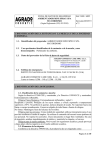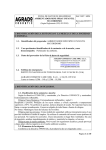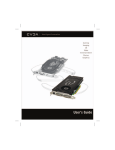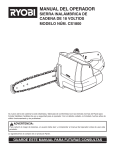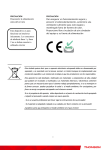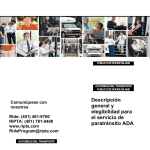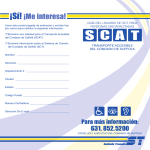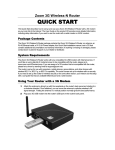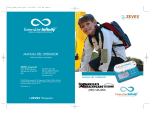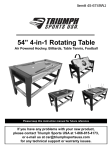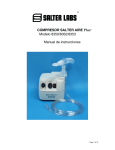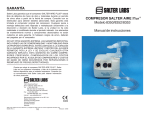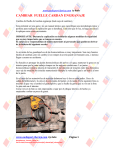Download Sample Dairy Safety Instructions for Employees
Transcript
Sample Dairy Safety Instructions for Employees If, at any time, you feel you cannot do a job safely, stop and discuss it with us and we will work together to fix the problem. We will walk you through our safety guidelines, however read it carefully and make sure that you understand it, your needs are addressed and your responsibilities are understood. If you do not understand any section, ask for an explanation. Work clothes You are expected to come to work dressed in suitable clothes that do not pose a safety risk. Suitable clothes include: sturdy work boots with non-slip soles for general work on-farm; tough overalls or long, washable trousers; a comfortable long-sleeved shirt – the sleeves should be either buttoned at the wrist or rolled up so that no loose ends can be caught in machinery or on protruding materials, the shirt should also be tucked into your trousers for the same reason; a broad-brimmed hat and wet weather gear for outdoor work You are expected to wash your work clothes daily, particularly after working with chemicals. Hygiene/Health Attention to personal hygiene is essential. It is in the interests of your health and our business – our milk must be of the highest standard possible. If you are a smoker, we will support your attempts to quit, as smoking in a rural environment poses a fire risk. You must: ensure your skin, especially your hands, are kept clean and washed with soapy water after working, particularly after handling chemicals, manure/waste, detergents or animals; wash your work clothes daily; keep up to date with your tetanus vaccinations; not be in possession of, consume or be suffering the effects of alcohol or illicit drugs; promptly report skin infections to the owner/manager; not smoke in the dairy, vehicles or any other farm buildings; and advise the owner/manager of any prescription medicines you may need to take during working hours – this is particularly important if you use asthma medication. Use of protective clothing and equipment (PPE) Protective clothing and equipment is provided for your personal protection while you work with us. All personal protection equipment (PPE) should be used as instructed, cleaned properly after use and kept in good order. Let the owner/manager know if PPE is damaged or unavailable, or if you are having difficulty using the equipment provided. The PPE includes: rubber boots and aprons for work in the dairy; protective gloves for handling cleaning agents; hearing protection when noise is a problem; helmets when riding a motorcycle/all-terrain vehicle (ATV); protective gloves, face masks, coveralls and respirators for handling chemicals; sunscreen when working in direct sunlight; goggles or safety glasses for eye protection; and dust masks for the feed shed. Riding the motorcycle/ATV Motorcycles and all-terrain vehicles (ATVs) are dangerous if not handled properly. Do not use the motorcycle/ATV unless authorised, and you have been provided with instruction and training. You may only use it on a public road: - for work activities; and - if the motorcycle/ATV is registered; and you have a valid driver’s licence to use a motorcycle/ATV Wear suitable clothing, including tough trousers, boots and a helmet, when riding the motorcycle/ATV. Before setting out on the motorcycle/ATV, refuel and check that the tyres, guards, chains and brakes are in good working order. Undertake daily maintenance and report any problems immediately. No passengers are permitted on the ATV. Children under 16 years are not allowed to operate the ATV. Do not exceed the vehicle’s front and rear load limits. Moving cows to and from the dairy When cows have to be moved across a public road, ensure that the stock crossing signs are in place, the gates opened and the cows moved as quickly as possible. Milking Report any hazards in the corrals, dairy, milk line, milk house, bulk tank, and feed shed to the manager immediately. Cows that have a habit of kicking or being hard to handle should be reported to the manager. The cows have been vaccinated against Leptospirosis, but you should avoid being sprayed or splashed with urine. Children are not allowed in the dairy unless they are in the company of an authorised adult. Cleaning up after milking Hot water burns can occur during the cleaning process. Report poor line joins, including leaking or broken fittings. Entering the milk tank is prohibited – only authorised people are allowed to enter the milk tank. Hoses are to be laid out along the wall after wash down. All chemicals are to be returned to the chemical storage area and the store area should be locked. Handling chemicals The chemicals used on-farm include detergents and other chemicals used to clean the milk line and milk tanks, as well as veterinary chemicals and hormones used in breeding programs. Chemicals are also used to control insects, weeds, fungal diseases, mice and rats. Only use chemicals if you have been trained in their use and are authorised to do so. Anyone handling farm chemicals must comply with the instructions on the label If you cannot understand the label or have difficulty reading them, ask for help before continuing. The recommended personal protection equipment (PPE) should be worn during chemical mixing, application and clean up. Always have clean water available for washing down and cleaning clothes when using chemicals. When you have finished you job, the equipment should be washed down and the chemicals locked away in the chemical storage area. Equipment operation and maintenance Make sure you have received instruction and training, or have been assessed before you operate any equipment for the first time. Become familiar with the operator’s manual for all the machinery you operate. Read, understand and comply with all the safety warnings on machinery and equipment, and in the operator’s manual. Ensure the power has been turned off before removing the guards on any machinery for maintenance or testing. As soon as the job in finished, always replace a guard that has been removed for machine maintenance or to clear a blockage. Tell the owner/manager about guards that have been damaged or exposed moving parts on machinery that may present the risk of injury. Keys must be removed from machinery after use and placed in the key cupboard. Being ready for emergencies All accidents and near misses must be reported to the owner/manager. All injuries must be entered in the injury record book. __________________________ Before setting out each day, ensure you have enough water to keep you well hydrated. Always let someone know where you plan to be on the farm, particularly if you are on your own. If no one is about, write it down and leave a note in a conspicuous place. Employees with First Aid training: ________________________________________ First aid kits are located ________________________________________________ Emergency telephone numbers should be keyed into your mobile phone & listed in barn. They are ____________________ Two way radio ? Y/N ____________________________________________________ General The law requires the owner/manager to provide a safe workplace and safe systems of work. To help us meet that obligation, tell us of any safety hazard you come across in the workplace. The same laws require you, as an employee, to take care to ensure that the health and safety of others on the farm – including other workers, family and visitors. The law also requires us to protect the safety of visitors and contractors who enter this workplace. Please look out for hazards to the health and safety of family members, tank drivers and others who enter the workplace. There are sometimes children on this farm. Their safety is a high priority. Please be careful when driving vehicles or machinery – never reverse without checking for children. Children and passengers are not permitted on tractors or other farm machinery when it is in operation. If leaving a machine when the engine is running, ensure that the working equipment is disengaged and the brake applied. The safety of the people on this farm is our top priority Declaration I have read and understand the occupational health and safety instructions in this leaflet. I agree to do what is required to ensure that the health and safety of all people on this dairy farm is protected. Signed Date Signed Date Adapted from information supplied by the Australian Centre for Agricultural Health and Safety www.dairysafety.org.au Instrucciones de Seguridad en Lecherías para Empleados Si, en algún momento, no cree que pueda hacer un trabajo con seguridad, deténgase y discútalo con nosotros y juntos trabajaremos para arreglar el problema. Vamos a repasar nuestra orientación de seguridad. Sin embargo, léalo cuidadosamente y asegúrese que la entiende, que toman en cuenta sus necesidades, y que entiende sus responsabilidades. Si no entiende cualquier parte, pida una explicación. Ropa de Trabajo Se espera que llegue al trabajo con ropa adecuada que no corra un riesgo de seguridad. Ropa adecuada incluye: Botas dobles con suelas no resbalosas para trabajo general en la lechería Overol de material fuerte o pantalones largos y lavables Una camisa cómoda de manga larga – Se debe poder cerrar las mangas en la muñeca o remangarlas para que ropa suelta no pueda enredarse en máquinas o en materiales salientes, se debe remeter la camisa en el pantalón por la misma razón. Un sombrero y ropa para un clima lluvioso para trabajo afuera. Se espera que llave la ropa diario, especialmente después de trabajar con químicos. Higiene Poner atención al higiene personal es esencial. Está en el interés de su salud y de nuestro negocio – nuestra leche tiene que ser de la más alta calidad posible. Si usted es fumador, ayudaremos a que deje de fumar ya que fumar en un ambiente rural trae un riesgo de un incendió. Tiene que: Asegurar que la piel, más que todo las manos, se mantengan limpias y lavadas con agua enjabonada después de trabajar, especialmente después de tocar químicos, estercole/desechos, detergente o animales. Lavar la ropa diariamente Mantenerse hasta la fecha en la vacuna de tétano No estar en posesión de, consumir, o sufrir de los efectos de alcohol o drogas ilícitas Avisar de inmediato infecciones de la piel al mayordomo o patrón. No fumar en la lechería, vehículos, o cualquier otro edificio del rancho Avisar el mayordomo/patrón de cualquier medicina recetada que puede necesitar tomar durante horas de trabajo – de suma importancia si toma medicina para asma. Uso de Ropa Protectora y Equipo (PPE) Ropa protectora y equipo es proveído para su protección personal mientras trabaja con nosotros. Se debe usar todo equipo personal protectora (PPE) como está indicada, lavar adecuadamente, y mantenerlo en buena condición. Avise al mayordomo/dueño si el PPE esta dañado o no disponible, o si tiene dificultad en usar el equipo proveído. El PPE incluye: Botas de hule y delantales para trabajo en la lechería Guantes proyectivos para manejar agentes de limpieza Tapones o protección de oído cuando hay problema de ruido Casco cuando monta motocicleta/ o un vehículo de todo-terreno (ATV) Guates protectores, mascara, overol y respiradores al manejar químicas. Bloqueador de sol al trabajar afuera en el sol Gafas protectoras para proteger los ojos; Mascara de polvo al entrar el almacén de alimentos Montar la motocicleta/ATV Motocicletas y vehículos de todo terreno son peligrosos si no se usa de manera apropiada. No use la motocicleta/ATV sin autorización y sin que le hayan dado instrucciones y entrenamiento. Solo se puede usar en una calle publica, - Para actividades de trabajo, y - Si está registrada y usted tiene una licencia válida para usar una motocicleta/ATV Vístase con ropa adecuada que incluye pantalón de material fuerte, botas, y casco cuando se monta la motocicleta/ATV. Antes de salir en la motocicleta/ATV, rellene el tanque con gasolina y asegurar que las llantas, cadenas, y frenos están en buenas condiciones. Haga el necesario mantenimiento diario y avise cualquier problema de inmediato. No se permite pasajeros en el ATV. Niños menores de 16 años no se permite operar el ATV. No exceda los límites de peso de adelante ni detrás. Entrar y Sacar Vacas de la Lechería Cuando se tiene que cruzar vacas por una calle publica, asegúrese que los avisos han sido puestos, las puertas de las cercas abiertas y que las vacas cruzan lo más pronto posible. . Ordeñar Avisar sobre cualquier peligro en los corrales, lechería, líneas de leche, almacén de la leche, tanque de leche, y almacén de alimentos al mayordomo/patrón de inmediato Vacas que tienen maña de patear o son difíciles de manejar deben ser reportadas al mayordomo o patrón. Las vacas deben tener la vacuna contra Leptospirosis, pero usted debe evitar que le rocíe o salpique orina No se permite niños en la lechería a menos que estén en compañía de un adulto autorizado Limpieza después de ordeñar Quemaduras de agua caliente pueden ocurrir durante el proceso de hacer la limpieza. Reportar problemas con las conexiones de los tubos plásticos o metales, incluyendo problemas con gotera accesorios rotos Entrar el tanque de leche es prohibido – solo gente autorizada pueden entrar el tanque. Se debe regresar las mangueras a su lugar después de usarlas para la limpieza Todas químicas se tienen que regresar a su puesto adecuado que debe estar bajo llave El manejo de químicas Los químicos usados en la lechería incluyen detergentes y otros químicos que su usan para limpiar las tuberías y tanques además de las químicas que usa el veterinario y hormonas usadas en el programa de crianza. También se usa químico para controlar insectos, las malas hierbas, enfermedades de hongos, ratones y ratas. Solo use químicos si ha sido capacitado en el uso y si se lo han autorizado Toda persona que toca químicos de rancho tiene que cumplir con las indicaciones en la etiqueta. Si no puede comprender la etiqueta o tiene dificultad en leerla, pida ayuda antes de seguir. El equipo personal de protección recomendado debe ser puesto mientras se mescla, aplica, y limpia el químico, Mantenga siempre agua limpia para limpiar el área y lavar la ropa al usar los químicos. Al terminar el trabajo, se debe limpiar el equipo y dejar bajo llave los químicos en el almacén de químicos. Operación y Mantenimiento del Equipo Asegúrese que ha recibido instrucción y capacitación o que le han evaluado antes de operar cualquier equipo por primera vez Familiarícese con el manual del operador para cualquier maquinaria que usted maneja Lea, comprenda y cumpla con todos los avisos de seguridad en la maquinaria y equipo y en el manual del operador. Asegúrese de que se ha apagado la maquina/equipo antes de quitar las guardias en la maquinaria antes de realizar mantenimiento o pruebas Justo al terminar un trabajo, reponga cualquier guardia que haya sido quitado para realizar mantenimiento o desatascar la maquinaria. Avise el dueño/patrón sobre una guardia que haya sido dañada o que haya expuesto partes móviles en la maquinaria que presentan peligro o riesgo de accidentes Quite las llaves de la maquinaria después de uso y póngalas en el lugar indicado Alistarse para cualquier accidente Se debe reporter todos los accidentes y casi accidentes al mayordomo o patron. __________________________________________ (Anote todas heridas y daños en la libreta de accidentes) Antes de empezar el día, asegúrese de tener suficiente agua para mantenerse hidratada. Siempre avise a alguien donde va a estar en el rancho, aun más si está trabajando solo. Si no hay nadie cerca, deje una nota y déjela en un lugar visible Empleados capacitados en primeros auxilios: _______________________________ Botiquín de primeros auxilios ____________________________________________ Usted debe tener los números de emergencia en su teléfono y también deben estar anotado en el rancho. Los números son: ____________________ Radio de dos vías? S/N _______________________________________________ General La ley exige que el dueño/mayordomo provee un lugar de trabajo seguro y sistemas de trabajo seguros. Para ayudarnos cumplir con esto, avísenos de cualquier peligro de seguridad que encuentre en el lugar de trabajo. Las mismas leyes exigen que usted, como empleado, haga su propio para asegurar que la salud y seguridad de otros en el rancho – incluyendo otros trabajadores, familia, y visitas. La ley también exige que protejamos la seguridad de visitas y contratistas que entren este lugar de trabajo. Por favor, esté al tanto de peligros a la salud y seguridad de parientes, motoristas de camiones y otra gente que entre el lugar de trabajo. A veces hay niños en este rancho. Su seguridad es de suma importancia. Por favor tenga cuidado cuando maneje vehículos o maquinaria – nunca marcha atrás sin verificar que no hay niños. Niños y pasajeros no son permitidos montar tractores u otra maquinaria del rancho cuando están en uso. Si deja una maquina mientras sigue el motor asegúrese que las partes que trabajan no están puestas y que el freno esta en uso The safety of the people on this farm is our top priority Declaración Yo he leído y entiendo las instrucciones de salud y seguridad en este folleto. Estoy de acuerdo hacer lo necesario para asegurar que la salud y seguridad de toda la gente en esta lechería es protegida. Firma ________________________ Fecha ______________________ Firma ________________________ Fecha ______________________ Adaptada de información proveída por el Australian Centre for Agricultural Health and Safety











